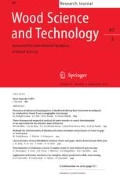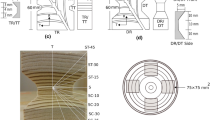Summary
An investigation of fatigue failure in wood subjected to load cycles in compression parallel to grain is presented. Small clear specimens of spruce are taken to failure in square wave formed fatigue loading at a stress excitation level corresponding to 80% of the short term strength. Four frequencies ranging from 0.01 Hz to 10 Hz are used. The number of cycles to failure is found to be a poor measure of the fatigue performance of wood. Creep, maximum strain, stiffness and work are monitored throughout the fatigue tests. Accumulated creep is suggested identified with damage and a correlation is observed between stiffness reduction and accumulated creep. A failure model based on the total work during the fatigue life is rejected, and a modified work model based on elastic, viscous and non-recovered viscoelastic work is experimentally supported, and an explanation at a microstructural level is attempted. The outline of a model explaining the interaction of the effect of load duration and the effect of the loading sequences is presented.
Similar content being viewed by others
Author information
Authors and Affiliations
Additional information
Received 8 December 1997
Rights and permissions
About this article
Cite this article
Clorius, C., Pedersen, M., Hoffmeyer, P. et al. Compressive fatigue in wood. Wood Science and Technology 34, 21–37 (2000). https://doi.org/10.1007/s002260050005
Issue Date:
DOI: https://doi.org/10.1007/s002260050005



